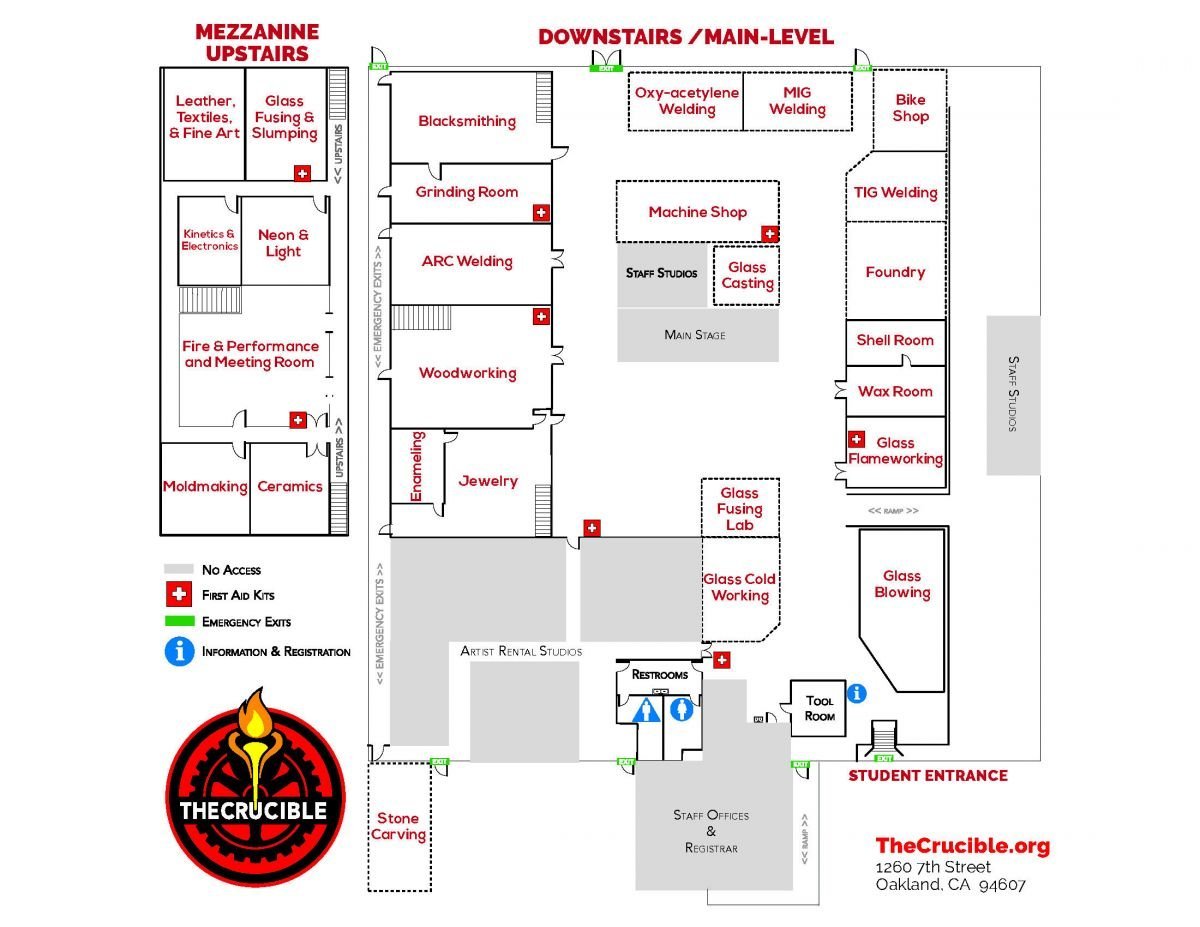Enameling Classes
Enameling is the colorful result of fusing powdered glasses to metal, using high heat to form a durable vitreous coating. The first enamels date to the 6th Century BC, in ancient Cyprus. At The Crucible, we teach both traditional and experimental application techniques, onto various metals. Students make objects ranging from fine cloisonné jewelry to large-scale steel sculptures and wall pieces.
Step Inside Our Enameling Department
Enameling Adult Classes
The Crucible offers a wide variety of adult classes teaching different enameling techniques. Whether you want to learn the fundamentals of torch firing or painterly shading techniques of cloisonne, The Crucible has you covered. See the complete list of enameling classes offered below.
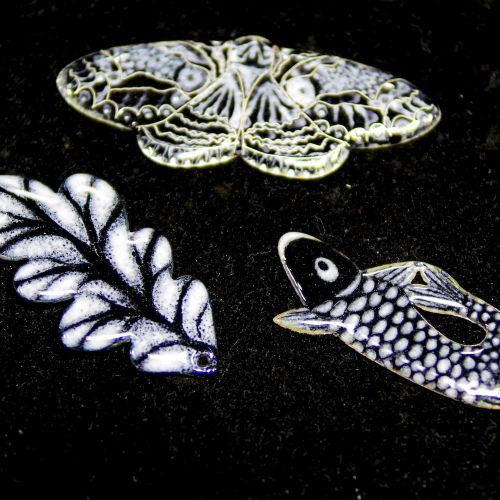
20-Shades of Grey: Medieval Enameling Techniques
Often associated with medieval French enameling, grisaille (grey) is the application of white enamel to a black enamel background, creating halftones and shading. We will also explore sgraffito-style grisaille and other experimental approaches.
PREREQUISITE: Enameling I

3-Hour Taster: Enameling
3-Hour Tasters are a great way to explore a new art form without the deeper commitment of a full course. After a basic introduction to enamel sifting and kiln-firing, make a stenciled enamel pendant or keychain to take home. Take a Taster and meet new friends or give the gift of creativity to someone special.
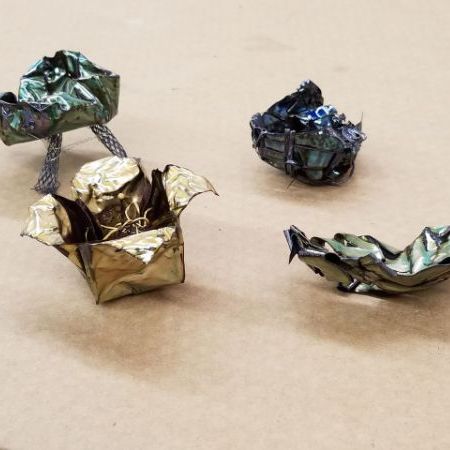
A Primer in 3-D Enameling
Explore the art of 3-D metal forms with Judy Stone in this introductory one-day workshop. We will work with soft copper sheet, mesh, and copper wire. Students learn to plan for adding enamel to forms and how to fire forms. Spray equipment, industrial enameling materials, and traditional jewelry enamels are used.
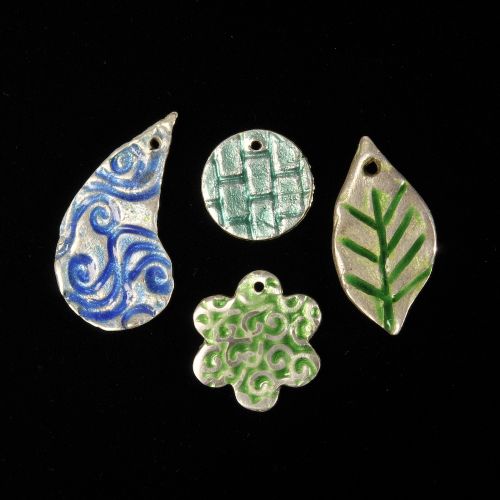
Art Clay With Color
Metal art clay is a material in which fine particles of pure silver are bound with a non-toxic organic binder that creates a clay. You work with the clay, and then it is fired into a solid piece of fine silver! We’ll then prep the silver in order to add a splash of color with vitreous enamels, fusing colored glass onto your silver in the kiln. You’ll leave the class with a pendant or a pair of earrings.
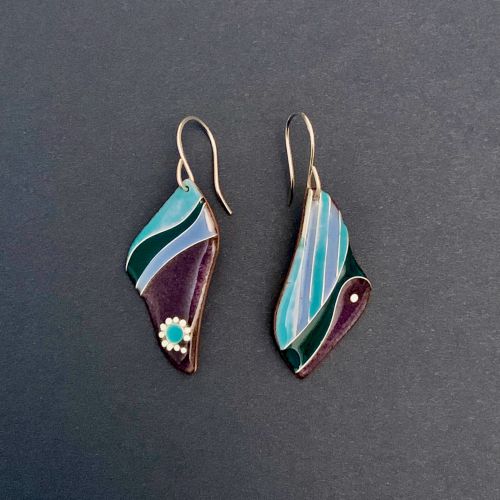
Beginning Cloisonne
Learn the basics of cloisonné enameling, a technique that has been practiced throughout the history of this wonderful medium. Cloisonné involves using thin silver wire to divide sections (cloisons) of a piece of copper. The sections are then filled with different colored enamel. Students will create graphic, color-block style pieces and translate line drawings into enameled jewelry or small works of art.
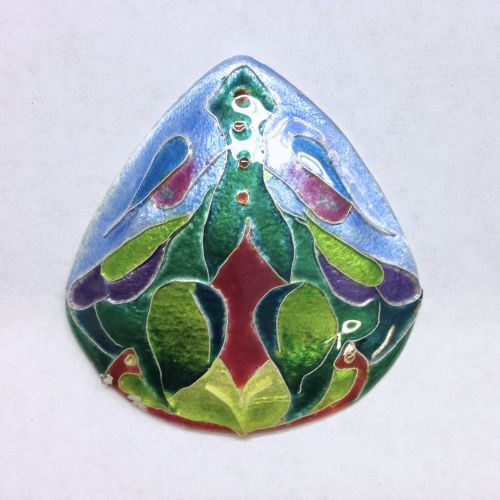
Cloisonne Intensive
Cloisonné, meaning “to partition” in French, is one of the oldest enamel techniques. The fusing of fine wires, to a base coat of enamel, creates the framework. The design is built up by placing the various enamel colors into the cells that are formed by the wires.
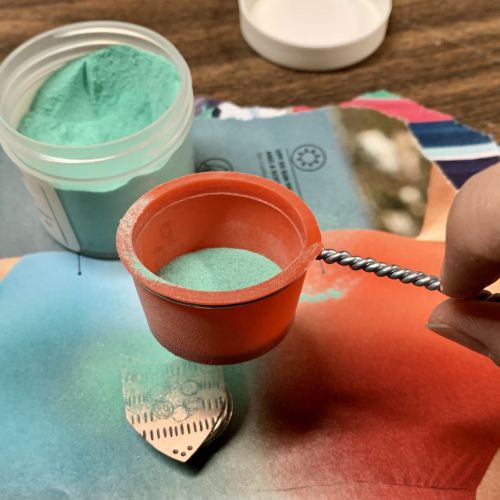
Color and Pattern – Stamped and Enameled Jewelry
Get a taste of both metalsmithing and enameling in this fun class! Students will start in the jewelry studio, where they will learn to pattern and texture metal. Then, we will apply underglaze and transparent enamels to add color and emphasize the pattern. Students will make one or two finished pendants or pairs of earrings.
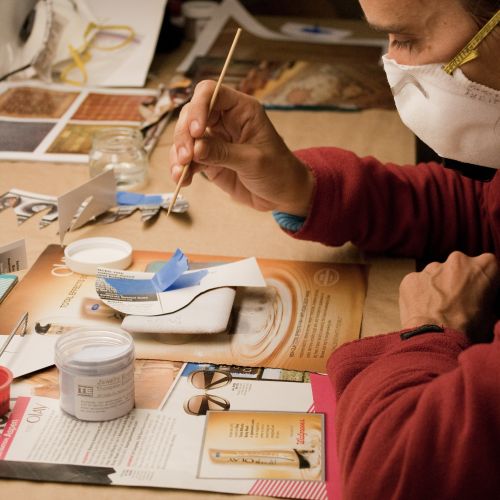
Continuting Enameling
Work with master enamel artist Judy Stone to further develop the skills learned in Enameling I, including torch firing, basic enamel painting, and working with precious metals and 3-D forms. In addition to a lot of experimenting, students will produce at least three finished pieces.
PREREQUISITE: Enameling I
Enamel Drawing
Line drawings can evolve into beautiful pieces of decorative or wearable art when interpreted in vitreous enamels on copper. Students will practice using transparent enamel to enhance drawings made in the metal itself (‘basse-taille), scratching lines through unfired enamel to reveal the surface underneath (‘sgrafftio’), and surface drawing using special pencils, pens, chalk, or crayons. No drawing experience needed—the simplest doodle can yield great results.
Enamel Hearts
Spend the morning making an original heart-shaped pendant for your valentine, pet, or yourself—just in time for Valentine’s Day! Sweetly sentimental or post-apocalyptic, the end result is up to you. Cut your own individual heart shape in fine gauge copper, add texture and dimension, then apply powdered vitreous enamels and fire in the kiln to add color and vibrancy.
Enamel Open Studio Hours
The perfect opportunity to practice the skills you learn in class, meet other enameling students, purchase supplies at a huge discount, and explore new possibilities with your craft! Enameling Faculty will be present to answer questions, manage safety, and provide overall support. You are free to work on your own projects and come and go at your convenience during open studio hours. Some supplies will be provided and you will have the use of studio tools.
Enamel Ornaments
Add a special touch to your holiday traditions with an enameled ornament of your own design. Using flat, precut copper shapes as a base, layer colored opaque glass in stenciled designs, then fire it in the kiln to create a unique ornament you can pass down from generation to generation. Finish your ornament with a decorative hook to add to your tree or give as a gift.
This class is part of Family Day, where parents and guardians with children ages 8 and up are welcome to register with their kids and get hands-on making ornaments—just in time for the holidays.
Enamel Surfaces
In this introduction to surface alterations, students will practice additive and subtractive enameling techniques both during and after the final firing. Additive techniques include firing sand, seed beads, glass pieces, metal pieces, or inorganics, while subtractive techniques involve abrasion, etching, and burnishing to bring the piece anywhere from a rough matte to a glossy satin.
Enamel With Mesh, Wire, and Foil
Students will work with lightweight metals such as copper foil, mesh, and wire which can easily be formed by hand and enameled to make dimensional objects. Learn the secrets of folding, bending, tabbing, sewing, and weaving to give seemingly fragile materials texture, weight and heft. If you know some origami it can be put to good use. Our enamel will not only add color to our formed objects but act as a glue and a strengthener for the structures we make. No prior enameling experience is necessary.
Enameled Stainless Steel Bowl
In this 3-hour course, students will learn how to prepare a stainless steel bowl for enameling and airbrush it with liquid white enamel. Using sgraffito, a decorative scratching technique that reveals a lower layer of a contrasting color, students will make their own design in the white enamel, then fire the bowl, leaving with their own unique enameled steel vessel!
Enameling I
Discover the ancient art of fusing glass to metal. You will learn techniques in metal preparation and fabrication for enameling, kiln properties and firing methods, properties of enamel, and dry and wet applications.
Enameling Lab
Lab sessions are a great benefit, exclusively for Crucible members! Practice the skills you learn in class and explore new possibilities with your craft. No instruction is provided during lab sessions, but a lab monitor will be present to answer questions, manage safety, and provide overall support. You are free to come and go at your convenience during open lab hours, however you must provide your own materials.
PREREQUISITE: Enameling I and Crucible membership
Exploring Liquid Enamels
Originally formulated to glaze steel in the 1800s, liquid enamels are referred to as industrial or porcelain enamels because of their similarity to ceramic glazes. They can be painted, splashed, airbrushed, and combined with other media to add spontaneity to enameling. Students will use these enamels, in conjunction with more standard forms of enameling, to create several test tiles and a small wall piece on copper. This is an entry-level class, although those with basic enameling skills are welcome.
Fred Ball Experimental Enameling Techniques
Fred Uhl Ball (1945-1985) was an enamelist who lived and taught in Sacramento. His work was viewed as highly unorthodox at the time, but created a firm basis for current contemporary enameling. Specific techniques include working with fire scale, creating collages, using liquid enamel and other materials associated with the porcelain enamel industry, over- and under-firing, and much more. Explore this inspiring approach with Judy Stone.
PREREQUISITE: Enameling I
Painting With Glass
You will be introduced to Limoges, a classical enameling technique developed during the Middle Ages in France. Starting with a domed copper base; fired white enamel forms the base coat on which to paint. With various painting materials mixed with water or oil, you can create your own color pallet and a unique work of art! Students will finish two complete pieces. Painting enamels are a way to achieve fine detail as well as delicate watercolor-like washes.
Plique-a-Jour: Stained Glass Enameling
Plique-à-jour (open to light) is the most admired of the many enameling techniques with French names. Enamel is fired into a backless frame creating a luminous effect similar to looking through a stained glass window. In this class you will learn how to design, make, and finish pierced plique-à-jour pieces, sawing out metal and filling the spaces with vitreous enamel. We will work with fine silver and various enamels to make pendants and earrings. PREREQUISITE: Enameling I
Re-Enameled Camping Ware
Camping ware is made of enameled steel. It usually has a solid color or granite finish. In this class students will use enamels in liquid form to make what is a normally drab utilitarian object into a work of art. Students have the option of working on a plate or a mug. The enamels can be sprayed, painted, dipped, dripped, spattered or stenciled and then fired. Subsequent firings can add additional color or drawing. A treasured re-enameled piece of rugged camping ware will make enjoyment of the great outdoors even greater.
Saw and Solder Champleve
Champlevé is a beautiful enameling technique where recessed areas in metal are filled with vitreous enamels. Using design techniques like sawing, filing, sweat soldering, wet packing, stoning, finishing, and patina, students will create a design in metal, solder it to a metal backing, then fill the open areas in the design with colorful enamels to be fired in the kilns. Students will complete at least two earrings, pins, or pendants.
Torch Fired Enameling
Learn how to use the torch to fuse glass to metal! Working on copper, you will learn the basics of how the enamel medium works and how to fuse using the torch. We will go over metal preparation, enamel application, and the special considerations of using a torch for fusing. You will leave with several completed projects, including a pair of earrings and a pendant.
Watercolor Enamel Earrings
In this three-hour course, you will create a unique pair of earrings of your own design! Starting with a white opaque enamel base, you will add layers of watercolor underglaze enamels to paint your own design. Watercolor enamels can be mixed just like watercolors to create a wide range of color options. After many firings, you will leave class with a hand designed pair of enamel earrings!
Enameling Youth Classes
In the Enameling Department, we offer youth classes specifically for ages 12-18. In these classes, The Crucible provides a unique setting for youth to get hands-on with enamels, exploring their creative voices and absorbing real-life lessons in science, technology, engineering, and math. You can see all The Crucible’s offerings for youth here.
Youth Enameling (ages 12-18)
Discover the ancient art of fusing glass to metal. You will learn about metal preparation and fabrication for enameling, kiln properties and methods for firing, properties of enamel, and dry and wet application techniques.
Meet The Enameling Department Heads
Judy Stone
Judy first encountered enameling in 1968 while studying on a Fulbright fellowship in Germany. She later recalled, “One day I saw a piece coming out of a kiln. It was molten red and as it cooled I could see brilliant color emerging. It was the alchemy of that transformation that piqued my interest.” After settling in the San Francisco Bay area in 1972 she taught herself to enamel, and has been involved at The Crucible since the beginning.
Miranda Anderson
Miranda’s artwork explores the intersection of line, light, and color by combining engraving and enameling. Her work has been exhibited in California, Pennsylvania, and Italy, as well as with the Glass Art Society. She is excited to be joining the Enameling Department at the Crucible.
Being Prepared For Your Enameling Class
Enameling classes are held on the first floor of our building. Please contact us if you have any questions about accessibility and we will be happy to accommodate.
Students must arrive for class in all-natural fiber clothing, long pants, and closed-toe, closed-heel shoes with socks that protect up to the ankle. Long hair must be tied back. Nylon, polyester, spandex, or other synthetics are not allowed around machines, equipment, or processes that can produce hot fragments, sparks, or flames.
The Crucible requests students always arrive in studio safe clothing when working. Layers are encouraged as the studio can be very cold or very hot. Learn more about enameling from our online guide.
